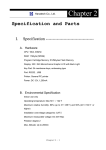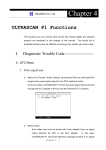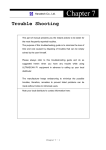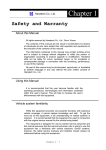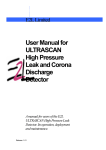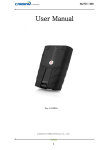Download Chapter 5
Transcript
Hanatech Co., Ltd. Chapter 5 Generic OBD2 I. Literal definition of OBD and OBD2------OBD is an abbreviation for On Board Diagnostics. OBD-1 is in reference to Title 13 California Code 1968 titled "Malfunction and Diagnostic System for 1988 and Subsequent Model Year Passenger Cars, Light-Duty Trucks, and Medium-Duty Vehicles with Three-Way Catalyst Systems and Feedback Control." filed on 11-15-85. This required cars sold in California to have an on-board computer processor for on-board self-diagnostics of computer sensed emission related components, fuel metering device and EGR (exhaust gas recalculation system). A partial or total malfunction that exceeded exhaust emission standard would illuminate a MIL (malfunction indicator light) and provide on-board identification of the malfunction location. To provide malfunction location information, codes are stored in onboard computer memory. To read codes manufactures use methods, such as flashing MIL light or various serial data protocols. OBD-2 is in reference to Title 13 California Code 1968.1 titled "Malfunction and Diagnostic System Requirements-1994 and Subsequent Model-Year Passenger Cars, Light-Duty Trucks, and Medium-Duty Vehicles and Engines. Filed on 8-27-90 to Air Resouce Board (ARB) This requires a standard electrical connector, open source standardized diagnostic trouble codes (DTC), data, and communication protocol with more specific self-diagnostic on-board monitoring of emission malfunctions. Chapter 5 - 1 USER MANUAL For ULTRASCAN P1 II. More practical notes -------------------------A. Technical meaning of OBD2 1. Standardization a For the technicians and scan tool engineers, OBD2 has its technical meaning as bringing the standardized methods of vehicle diagnosis to the chaotic aftermarket where dozens of car make use different diagnostic adapters and communication protocols of their own. b The 16-pin trapezoid diagnostic adapter and a few of most influential communication protocols including ISO9141-2, KWP2000, and SAE J1850 VPW and PWM form the standard OBD2 specifications. c Trouble codes and Data stream variables were also standardized and opened to public, so that all the scanners that support aforementioned standard communication protocols through the 16-pin OBD2 adapter can always get the same readouts. 2. Purpose of OBD and OBD2 a. OBD and OBD2 are the names of regulation that were legislated in USA for the emission control. b. On board diagnostics was implemented to monitor malfunction or failure of the emission related parts and components to minimize the possibility of excessive exhaust gas emission by letting the driver know that the car has a problem and the technician immediately perceive what is the problem when any trouble is detected in the emission control system. And OBD2 became effective later to increase the efficiency of OBD by standardization. Chapter 5 - 2 Hanatech Co., Ltd. Chapter 5 B. Generic OBD2 and Enhanced OBD2 1. Generic OBD2 a. OBD2 was implemented for the emission control. Therefore, the standardization is limited to powertrain system that is directly related to emission control. It is not mandatory for the other systems such as ABS and SRS b. Not all the trouble codes and data stream variables are standardized, also. A list of trouble codes and data stream variables that are closely related to emission control are defined as OBD2 standards, however, it also allows more codes and variables reserved for car make’s own definition and usage. These standardized parts of trouble codes and data stream variables are so called Generic OBD2. Generic OBD2 application is limited to emission related systems and so is the diagnostic readouts 2. Enhanced OBD2 a. Generic OBD2 has limited availability for overall diagnosis, however, an actual car has a lot more than this. The control systems other than powertrain are not included in the mandatory OBD2 regulations, and each car make has different trouble code and data stream definitions for the reserved non-standard fields of powertrain system. b. The scope of on board diagnostic system that OBD2 standard features do not cover is called Enhanced OBD2. 3. Manufacturer’s OBD a. Many of Non-USA cars of 1996 model-year or later have an OBD2 16Pin adapter, however the communication with scanners does not follow standardized OBD2 protocols. b. These car makes maintain their own communication features that are not Chapter 5 - 3 USER MANUAL For ULTRASCAN P1 much different from OBD generation 1 but only the appearance of diagnostic adapter. This is so called MOBD or manufacturer’s OBD. c. In ULTRASCAN P1, MOBD communication is supported for all car makes that are included in the coverage list. Chapter 5 - 4 Hanatech Co., Ltd. Chapter 5 III. ULTRASCAN P1 and OBD2 ---------------A. Generic OBD2 in ULTRASCAN P1 1. General OBD2 a You will find Generic OBD2 category after choosing 1. SCAN on the initial menu of ULTRASCAN P1 as shown below. b Selecting [2. Generic OBD2/EOBD] and Press “ENTER” key. ULTRASCAN P1 then automatically tries to establish communication with the powertrain control module using OBD2 J1850 protocol. Below procedure will be followed automatically. Chapter 5 - 5 USER MANUAL c For ULTRASCAN P1 When succeeded in communicating with the control module with any of these 4 standard protocols, ULTRASCAN P1 reports the successful establishment of communication and waits for your command to commence generic OBD2 diagnosis as below: d Available functions for the generic OBD2 system is listed as shown below: e In case the control module does not respond after trying all OBD2 standard protocols, ULTRASCAN P1 shows the failure report and check Chapter 5 - 6 Hanatech Co., Ltd. Chapter 5 points as below: 2. When to select You may select this General OBD2 when you are sure that the test vehicle is OBD2 compliant but not included in the vehicle coverage list. 3. EOBD a In Europe, EOBD has become mandatory from January 1, 2001, and all the cars built in Europe since then on must have been generic OBD2 compliant. b You may select General OBD2 of ULTRASCAN P1 for the diagnosis of European cars for 2000 and later model year vehicles for the powertrain system. Chapter 5 - 7







